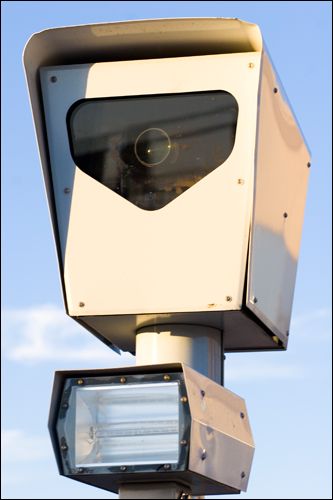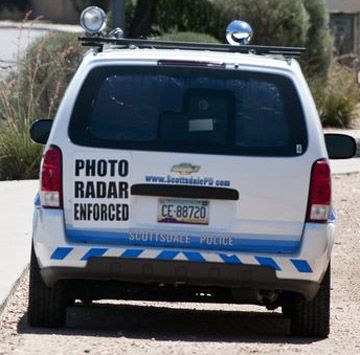(Forward: The information I will share with you in this article is
based upon my 20-years of experience as a sworn law enforcement officer
and my 18 plus years in the speed counter measurement industry.
However, I am not an attorney nor am I a member of any state bar, so please do
not consider any of this information I am sharing with you as legal
advice, as I am not in a legal position to offer it.)
 Photo enforcement is big business!
Photo enforcement is big business!Local,
state, and federal governments throughout the world have teamed up with
companies like Reflex, American Traffic Solutions, Gatso, and Redspeed
to automate various forms of traffic enforcement, including toll
enforcement, speed enforcement and red-light camera enforcement.
Most
jurisdictions justify their purchase of photo enforcement cameras by
citing accident statistics and tout their pursuit of saving lives.
They
implement photo enforcement under the guise of preventing accidents in
"high-accident" areas, and then claim that these photo enforcement
cameras have saved lives and prevented accidents.
They fail to include in their reports that the accidents in these "high-accident" locations are not usually caused by people only going too fast, but other factors possibly
combined with speed.
What they do not mention, at least to outside sources, is that it is a great way to make money for the treasury.
The real reason cities use photo radar is for revenue generation.
Cities are able to gain huge amounts of money for little or no cost due to personnel or equipment. Money is also the reason why you sought this information, instead of paying a fine in excess of $400.00, in some cases.
Photo enforcement is a money making tool. The more money it can make without cost to the city the better. To lower the cost to themselves, the city lets the photo-radar company do a lot of the work.
The city contracts companies that specialize in the field of photo radar to maintain and implement the devices.
Then, each day employees from these companies look over the pictures of speeding vehicles taken by the devices and cross-reference the license plate number with the Dept. of Motor
Vehicles to see to whom the vehicle is registered.
They then send out a ticket in the mail to the address on record for that person. If
the offender looks female, they will send it addressed directly to the
female sounding name that is listed on the registration, and vice versa
for males.
They send an officious letter, with the ticket, to the registered owner of the vehicle, hoping they have the driver. This letter states that you have been caught on film for speeding. It also gives you four alternatives;
1) Admit guilt and pay the fine,
2) Attend a defensive driving class (at your expense)
3) Request a trial be set by mail
4) Tell them who the actual driver was.
For every ticket that you pay, a percentage goes to the contracted company and the rest goes to the city.
Not a bad arrangement, eh?
Back To Top
How Photo Enforcement Works
All Photo enforcement systems use a computerized photo system.
Radar, Laser or Sensors?
Photo enforcement devices use one of three methods to measure your speed:
- Low power radar guns: typically installed in mobile vans/SUVs.
- Lidar: used in both fixed and portable locations.
- Embedded Sensors: typically used in fixed locations, electronic sensors are embedded into the roadway.
Photo Enforcement Camera System:
Photo enforcement devices use either still digital photography, video
photography, or in some cases both, to capture your photograph.
Images Uploaded to Server:
Next, the images captured by the traffic enforcement cameras are
uploaded to a central server. Then a technician from the contractor
reviews the images and identifies the vehicle through license plate
records.
Result: You Ticket is in the Mail
The next step is you receive your citation in the mail.
Your summons usually gives three options:
- Pay a fine
- Go to Traffic School
- Appear in court to contest the violation
- Identify who the driver is, if it's not you.
What Option Will You Choose?
Pay the Fine
Surprisingly, less then 20% of the people who receive their summons in the mail pays the fine.
However, when you calculate all the people who do mail in their
money, along with the high number of summons that are mailed each day,
you see why photo camera enforcement has become such a cash cow for many
jurisdictions as well as camera contractors.
Go to Traffic School
Some jurisdictions allow you the option of having your citation
dismissed by taking either an online or in-person class on driver
safety.
Two advantages of this option are that your insurance company is
not notified of the offense, and you’ll learn something new about driver
safety.
Snitch on the Driver
If you’re not the driver, there is typically an area where you can check
off stating that you’re not the driver and then an area where you are
asked to identify the driver.
If you check off that you’re not the driver, they will examine your MVD photo against the photo on the citation.
If
it’s their determination that it is you, they could then file
additional charges against you with the court for providing false
information in a public document.
As far as snitching on the
driver, at this juncture you’re not under any legal obligation to do so,
so you can leave this area black, or write refused.
Fight it in Court.
A small number of people do contest their citation in court.
In these cases the contractor and/or jurisdiction will provide
expert witness testimony during your trial on how their system works and
the reason(s) you were cited.
Unless you have experience in courtroom procedure and/or hire an attorney, I would not recommend this option on your own.
Most People Ignore the Summons!
Now, most people who receive their ticket in the mail ignore the letter and do nothing.
I’ll explain later why this may be the best option for you to choose if you follow some of my simple guidelines.
Back To Top
Where to Watch Out
Photo Radar Vehicles

Photo Radar vehicles are usually placed in very strategic places,
where the police know people usually speed. These areas include school zones, construction zones, and roads where the speed limit is
too low for the surroundings.
As these vehicles are portable,
they frequently move from place to place, and their locations are not
typically stored in the photo enforcement databases.
Most of
these photo radar vehicles also use low powered radar guns that are
angled away from approaching traffic, making it very difficult for a
low-end radar detector to detect.
However, these photo radar
vehicles can be detected with a higher end detector such as the Escort
Max or the Beltronics STi Magnum.
Fixed Camera Locations
Most of the photo enforcement cameras you will encounter will be fixed location devices.
These fixed location cameras would include toll cameras, red-light cameras, speed enforcement and even smog detection.
Most
of these fixed camera locations use embedded sensors placed into the
roadway, thus making them impossible to detect with a radar detector.
However, as these are fixed locations, their exact location will be mapped in
photo enforcement databases like Escort’s Defender database which is
included in the Escort Max and Escort 9500ix radar detector.
Back To Top
Time Limit for Service - Statute of Limitations
Rules of Civil Procedure
The rules of civil procedure vary from state to state; it’s
recommended that you check the procedures applicable to your own
state/jurisdiction prior to following the tips outlined in this area.
The
Civil Procedure Code is in place to protect citizens in all civil
cases. It is a part of our justice system designed to protect everyone's
rights. It is in place for all civil matters.
Letter in Mail is Not Legal Service
According to the Rules of Civil Procedure (4(i)), if the court
fails to effectively summon you within 120 days of filing, it allows the
court to dismiss without prejudice (which means that it can be
refiled) or direct that service be effected within a specified time;
provided that the plaintiff shows good cause for the failure, the court
shall extend the time for service for an appropriate period.
This loophole cannot be closed without affecting the entire civil justice system.
This means it will probably be in place for some time, at least long enough for you to take care of your citation.
If
these conditions have not been met, you have not been served legally.
The government agency you are dealing with has the option of sending you
registered mail, or having you served personally.
If they send you registered mail you are not required to accept the letter.
You do not have to tell anyone your name just because they ask.
Also, you are not required to accept certified or registered mail.
Simply tell the postman you do not want to accept service of the letter without telling him or her who you are.
If they cannot get you by registered mail, the agency may try to serve you with a civil process server.
Next Comes the Process Server Knocking at Your Door

If a process server is sent to your home, the situation becomes a little stickier.
The service can be left with any person over 14 years of age in the house and service is valid.
The process server can find out if mail has been received at your address for you and use that to complete the service.
Once you are legally served you must appear in court, end of story.
The
other pitfall to this is that the government will likely charge you for
the cost of the process server. (Remember, it is a money making
proposition for the government.)
To protect yourself from their
service, instruct all members of your household not to answer the door
if a stranger is standing outside.
Also, if a stranger starts
approaching you or any member of your household while outside of your
home, have them walk away and not answer any questions if asked.
There
have been cases where the process server just stuffs the summons under
your door and they leave, marking the summons served.
If this
happens to you, you will then have to argue to the court that the
service was invalid. However, you may want to wait till after the 120
days of your violation for this hearing.
Back To Top
Fighting Your Citation in Court

One of the most common mistakes people make when preparing for court is not to prepare.
You must do some thinking about your case and why you are not guilty.
You must also have a plan of attack.
In about eighty percent of the traffic cases I have testified at, the defense of the violator was "Uh-Uh, did not".
Usually, after the officer testifies about date, time, location, weather
conditions, circumstances, identity of the driver, other traffic on the
road, etc., etc., the defendant tells the judge, "I was not speeding,"
and sits down.
So who do you think the judge will believe?
Your first step is to identify any problems with the photo enforcement system first.
This means you may have to do more detailed research into exactly how the particular company's system works.
Find
out what kind of radar they use, what kind of camera they use, what
kind of computer equipment and software is used, and also how the system
is linked.
In other words, how is the camera triggered when the radar detects a "speeder"?
Next, find out how the system is maintained.
Subpoena
the company's records of service and the maintenance logs for the
camera, the radar, and any computer equipment that is used in the
system.
Do not be put off by the court or prosecutor. It is your
right to subpoena any pertinent evidence in your defense. You might
consider getting subpoenas for the maintenance personnel from the
company also.
Questions You Need to Ask in Court
Obviously I cannot give a boilerplate set of questions for every court trial or every circumstance that you might encounter.
However, we do give the following examples of questions to give you an idea of how to proceed with your case.
Ask how many failures the company who monitors the system has had.
Don't
settle for a percentage or an estimate; make them tell you how many
they have had. If they do not keep records on this, it is an indication
you can present to the court that the system is flawed to the point that
the company does not want anyone to know.
You can also use this information to question the company about their record keeping policies.
If they don't keep records and report problems, how do they know there was no problem with the system when it took the picture?
Question the company about their maintenance policies. You can compare
this with the standards recommended by the manufacturer.
Most
radar manufacturers have web sites that make this information readily
available. Also, find out who is maintaining the photo radar systems and
how much training the technicians have had in each phase of the system.
You might just find that the technician is well acquainted with radar,
but does not fully understand the entire system's functions.
If so, how can he be sure a malfunction did not occur?
One other avenue you might want to explore is who issued the citation.
Find out what information the officer used to determine his reasonable suspicion.
You
might find that the officer has less of a basis for a citation than in a
normal traffic stop situation. Use this to challenge the issuance of
the citation.
The reasonable suspicion is less than the probable
cause required by a criminal citation, but it still must be clear and
arguable by the prosecutor.
The officer who issues the citation is relying solely on the machine to give him his reasonable suspicion.
This will make it harder for him to articulate his suspicion.
Back To Top